After I wrote a lengthy post about cold emailing, I got a number of people asking me: “Dmitry, can I use these examples for leads and prospects?”
My answer was always the same: not quite.
Cold emails are often different from conventional business messages.
With the former, your main objective is to grab enough attention to warrant a response.
With the latter, you know a lot more about your prospect (and vice versa). Your aim isn’t just to get noticed, it’s to meet your revenue goals.
As you can imagine, the subject line and tactics you should use change accordingly.
So in this post, I’m going to tackle this long ignored topic:
I’m going to show you 27 business email templates and what makes them perform for any campaign you’re running. You’ll walk away from this knowing exactly what to write in your next message to get opens, clicks and conversions.
Before you skim the templates below and start writing your own please go through the following checklist to ensure you pay attention to the following:
- a way to open rate – which ever tool you’re using should have this metric
- a way to measure response rate – which ever tool you’re using should have this metric
- are your emails targeting the right person in organization?
- are you addressing your target’s pain point?
- do you have a dedicated sales rep or a sales team to convert the leads into customers?
- are you using your personal Gmail or Gsuite? It’s better to spin up a new inbox with a company email for cold email outreach.
- do you have a specific landing page elements to show a potential customer with a testimonial from a loyal customer or a happy customer?
- are your emails displaying correctly on mobile devices?
- if you’re doing cold outreach it’s a good idea to have a special offer for your prospects
- be careful to filter out folks who are close to you: an existing customer or a subscriber or a big fan who loves your blog
- following up with people after hosting a webinar or a networking event, even if it’s through promotional emails is always a good idea
Ok, ready for some business email templates?
Let’s dive in!
Statista’s thoughtful customer-centric email
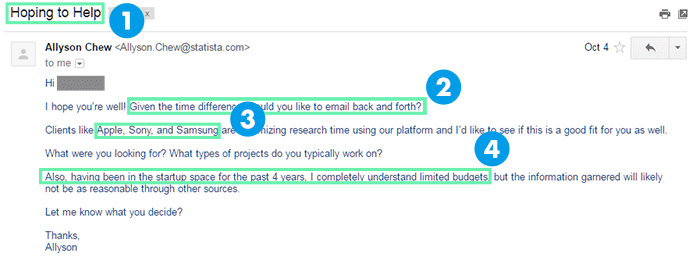
I recently received this email from Statista after I’d signed up for their free account.
This message was my first contact with Statista. They’d never spoken to me before. Nor did they have any information about me, besides what I’d shared when I signed up with them.
Here’s why this example knocks it out of the park:
- The subject line “hopes to help:” This sets the tone for the rest of the email. Statista doesn’t focus on winning a deal. It focuses on helping you make better use of its tools. It’s a subtle way of selling themselves, which I’m on board with 100%.
- They mention a “time difference.” Statista is based out of Hamburg, Germany. They’re 9 hours ahead of the U.S.’ Eastern time zone. So when Allyson asked if I prefer communicating over email, she was being thoughtful. There’s no back and forth about setting up a call at an awkward time.
- Social proof: I’m not going to buy a service just because a big name brand already uses it. But knowing that Apple trusts Statista gives me confidence in them.
- Budgetary concerns: As a small business owner, I’m often wary of emailing similar companies without transparent pricing. But Allyson proves she empathizes with me on this point by suggesting that Statista will have a solution that fits my budget.
Apart from this, also note the personal “I” tone, which is rarely used in first touch messages. Too many salespeople hide under a third-person pretense of “we.” By using the first person, and saying “I,” you make yourself and your business relatable.
The benefit-focused follow-up business email template
The biggest mistake you can make with follow-up messages is to leave your prospect in the dark.
If you’re simply saying “Just following up,” you’re basically bumping the email back to the prospect’s inbox. If he/she didn’t have enough reason to reply back earlier, simply bumping the email back won’t make your case any stronger.
That’s why I love this example from Avidian. It shows exactly how to work new information into a message thread.
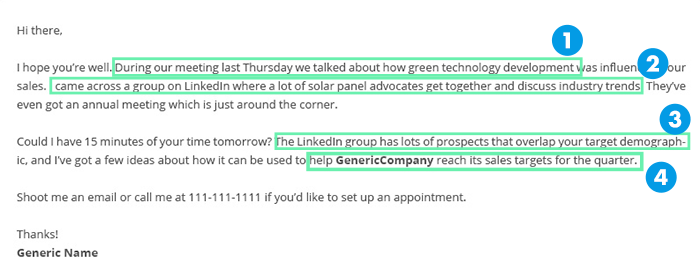
Here’s what I like:
- It starts with a reminder. Decision makers tend to be busy. Chances are they’re not going to remember who you are or why you emailed them. If you’re emailing after a long time, it’s a good idea to remind them of your last conversation and its context.
- New information: This template steers the conversation to new information and its relevance to the original conversation (in this case, a LinkedIn group).
- Reason for the email: This is a continuation of the above – why this new information matters.
- Benefit: Closing with a benefit works well. Closing with an urgent benefit – “reach sales targets for the quarter” – proves even better. After all, if you’re the VP of sales at a startup, wouldn’t you want to meet your sales targets as early as possible?
- Subject line: even though it’s not present in this template it’s the most important part of your email, keep it to 60 characters and make it punchy, for more ideas check out my guide with 100+ examples of an email subject line
The lead tracking follow-up
If you have a way to connect visitors on your site to businesses by using tools like WhoIsVisiting or HubSpot’s prospect tracking, you can get pretty creative with your messages.
For one, knowing that someone from the company you’re targeting is visiting your site can be a great icebreaker.
Here’s a template for using this trigger:

This one is pretty basic in its actual content, but it hits all the right marks:
- Tell the lead what her teammates were doing: This might seem like it’s a bit stalkerish, but the right way to send such an email is to tell your reader upfront what pages the teammates were viewing. Businesses understand that prospects are often tracked these days, so it won’t surprise them.
- Invite teammates to join the call: The “10 minutes to discuss” is standard, but inviting others to the discussion makes this closing line more effective.
Following up to a warm lead
Imagine this: A gentleman downloaded an eBook from your site last week using his name, email address and website.
After researching this information, you realized that he’s a perfect fit for your services.
What should you say to him?
Here’s a template courtesy of Attach.io:
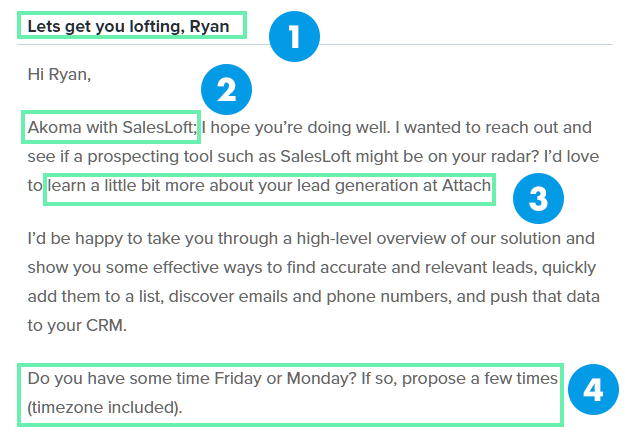
- Clever subject line: “Lofting” is a rare enough word that it will stand out in any inbox. “Let’s get you lofting” isn’t very benefits-focused, but it’s smart. And that’s usually enough to get an email opened.
- Simple Introduction: Since you captured the lead recently, there’s a good chance the prospect still remembers your brand name. Instead of a long-winded introductory emails, simply stating your name and your company is enough.
- Simple personalization: Personalization is critical but when you make it too complicated, it reduces your email velocity significantly. This one focuses on a single variable (“your lead generation at [company name]”), making personalization faster.
- Exact days/times: Instead of going back and forth to decide on a time/day, it’s sometimes better to propose a date yourself and let the prospect propose the right time for a call.
The second paragraph is a bit too long but given the succinctness of the first paragraph, I’d say this is a strong example of a warm follow-up.
Emailing a referred lead
As any seasoned salesperson will tell you, referral leads are worth their weight in gold. Knowing a common connection makes getting the foot in the door so much easier while also easing customer FUDs (fear, uncertainty and doubt).
But how exactly do you email a referred lead?
Here’s a template (credit: HubSpot):
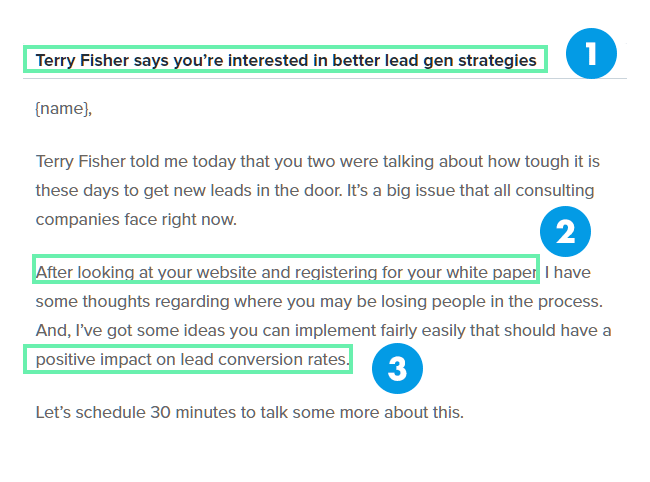
Here’s what to love about this:
- Referral name in subject line: You want your subject line to grab the prospect’s attention. Mentioning someone the prospect knows is a powerful way to do that.
- Show that you’ve done your research: This single line shows that you’ve actually done your homework. Important to show that you’re not just blindly emailing people.
- Close with a benefit: The business email template closes by asserting how it has ideas you can “implement fairly easily” and which will have a measurable impact on an important metric: lead conversion rates.
Sending warm leads more content
Sales is a game of months, not days. For high value prospects, you can expect to go back and forth over weeks on end.
During this time, you want to a) keep establishing common ground, and b) keep prospects interested by sharing relevant content.
Use this template from HubSpot to see how it’s done:
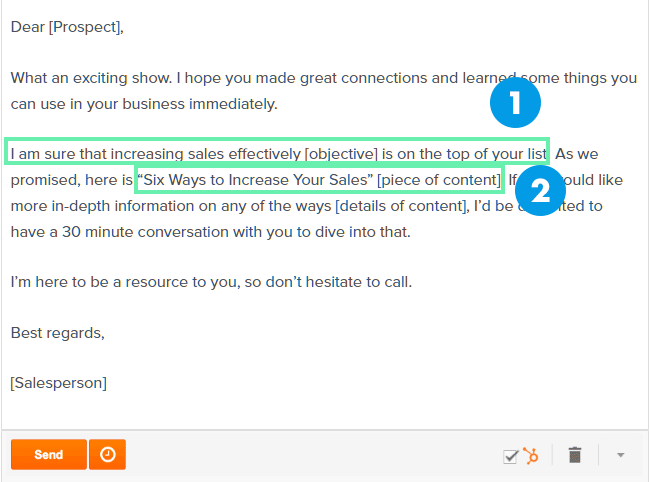
- References a shared experience: One way to establish common ground quickly is to mention an event or experience you both attended. This shows that you share the same interests and goals.
- Mention business goal: Sales emails aren’t meant to be chit-chat. After establishing a connection, circle back to the reason why you’re emailing them: because your service/product can help them meet their goals.
- Deliver relevant content: Pretty much the objective of this business email template. Using phrases like “As promised” is a good way to make it sound more natural.
- Subject line: again do not forget to focus your attention on subject line before writing your email.
Follow up after a phone call
A good sales practice is to always follow-up to phone calls with an email reiterating the points you discussed in the call. This is not only a good way to keep track of the conversation, but it also gives you a chance to send over any relevant documents or data.
Here’s a business email template you can use to do this:
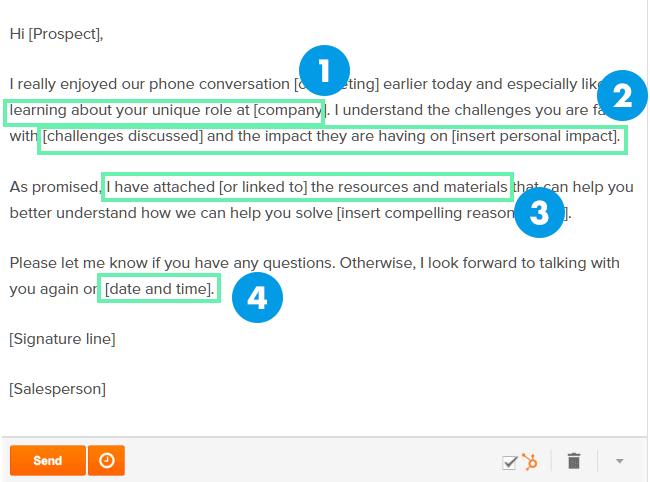
- Start by referencing the phone call: This is a pretty generic greeting but it’s personalized enough that it works. Your job is to quickly mention the phone call and the context of your conversation before getting to the meat of your email.
- Focus on “personal impact”: Remember, the people you are dealing with also want to advance their careers. If your solutions can help them solve personal issues, you’ll have a much better chance of getting their attention.
- Send additional data: If you’ve discussed any content, data or documents in the phone call, the second paragraph is a good place to mention it.
- Mention date and time for next meeting: Instead of wasting time going back and forth to find a suitable time, go ahead and mention the schedule that works best for you. If the prospect has any issues with it, she can easily get you to change it.
“Breaking up” with a prospect
Most of your leads won’t turn into sales.
And that’s okay.
Some leads won’t buy because they’re either not interested or can’t afford your product.
A lot of leads, however, are interested in your products but just don’t have the time to commit to a purchase right now.
Instead of fading off the radar for such leads, send them a “break-up” email telling them that you won’t be mailing them anymore.
Here’s the template (credit: Attach.io):
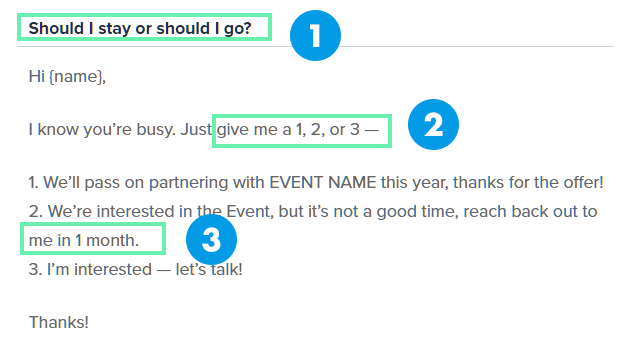
This business email template gets everything right:
- Clever subject line: This subject line will stand out in the prospect’s inbox (and probably earn you a nice chuckle). Plus, the song is perfectly relevant here.
- Make it easy for prospects to respond: Instead of writing a lengthy reason for the radio silence (or worse, no reply at all), give prospects an out by giving them pre-written response templates. Replying to this email will take a lead literally 10 seconds or less.
- Establish a timeline to restart the sales process: Notice how this email gives prospects a way to restart the sales process in 1 month. This catches all prospects who might be interested in your product but can’t commit right now.
The humorous “break-up” business email template
Humor – if you can make it work – is one of the most powerful sales weapons around. If your brand personality or the rest of your conversations have a humorous lilt to them, here’s a compelling sales template you can use:
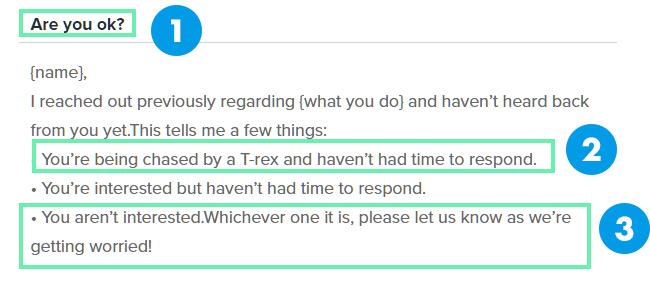
- “Are you okay”?: This subject line is designed to do one thing: get opened. Sure, it’s a little misleading, but be honest: wouldn’t you open an email like this as well?
- Simple but effective joke: As far as humor goes, this is pretty safe – and it works in context.
- Give prospects an easy way to respond: Similar to the above break-up email, prospects just have to say (1), (2) or (3) to indicate their preference.
The congratulatory “new announcement” business email template
Did one of your warm leads (or client) recently launch a new product or win a major accolade?
This is the perfect excuse to get back in touch and make a subtle push for your products.
Here’s a template from Yesware showing you how:
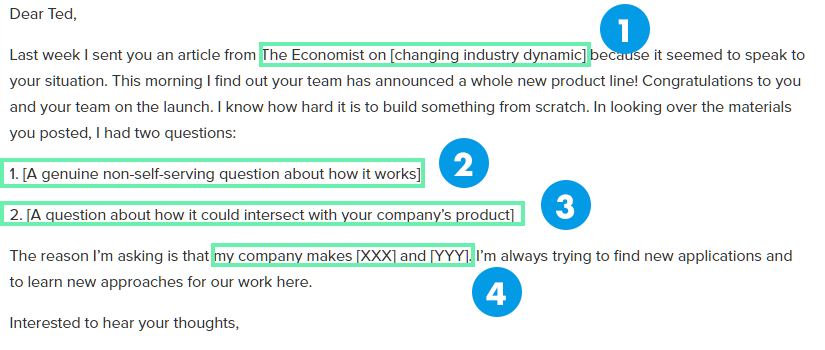
- Optional callback to last conversation. This is entirely optional but if you’ve recently interacted, it’s always a good idea to reiterate it when you email. Besides mentioning the what, you should also mention the why (here – “because it seemed to speak to your situation”). Once you’ve done that, skip straight to the congratulatory message.
- Ask a genuine question. It’s important here to skip cursory insight and ask something actually meaningful. You don’t want to come across as simply flattering the prospect.
- Circle back to your own product. While genuine insight and even flattery is nice, remember that you’re trying to close a deal here. Find a way to plug your product into the conversation. For instance, if your prospect just released a new CRM tool, you could mention how they would need PR to promote it (for which you make software).
- Give a reason for the email. A study by Harvard psychologist Ellen Langer showed that people are far more likely to let you do something (say, cut in a line or respond to an email) when you give them a clear reason. The line “the reason I’m asking” gives you a reason for the email. Plus, it allows you to plug your product in a way that benefits the prospect.
- Subject line: a good subject line for this template above is Scoop re: your story on [changing industry dynamic]
The value addition business email template
If you run a business, you should periodically send relevant content to your prospects.
The reason for this is twofold: a) you get to show that you’ve been thinking about the prospect, and b) you get a reason to get back to your prospect’s inbox.
If you’re sending content to your prospects, here’s a business email template you can use (again, from Yesware):

- Send content from a neutral party. While you might be tempted to send content from your own resource library, your objective here is to show that you’ve been thinking about your prospects problems, not just promoting your business. An article from a respected third party that’s relevant to the prospect works better in such situations.
- Ask for guidance. You’re a salesperson, not a clairvoyant. Instead of assuming the problem, ask for guidance with a question like the one above. Make sure that this question is relevant to the article you just shared.
Note how the email is short and keeps the congratulatory tone to a minimum. Flattery works, but only in tiny doses.
The introduction business email template
Your prospects have the same goal as you: to grow their businesses.
Introducing them to someone who can help them reach this goal is a win-win for everyone involved. You get into your prospect’s good books, while the prospect expands her network.
Here’s a good business email template to bring up an introduction:

- Jump straight to the purpose of the email. Understand that since you’re delivering a lot of value (introducing the prospect to a new contact), you don’t have to write a lengthy, flattering intro. You could even do away with the first couple of lines altogether.
- Introduce the person and how they can benefit the prospect. Take particular care to mention any specific topics or ideas they might have in common. This will give the prospect a starting point for the conversation.
The “get back in touch” email
If you’ve lost touch with a prospect, here’s an email from Yesware to start the conversation again.

Lots to love here, especially how it kickstarts the conversation by focusing on something relevant to the prospect.
- Give a reason for the email. This could be anything – a new product launch, a new announcement, or even a new blog post. This works much better than a simple “just following up” message since it gives you a way to tie your pitch to something the prospect cares about.
- Update your prospect about your product. Mention any product updates or recent changes at your company. This gives you a way to lead the conversation back to your product and also gives the impression that you’re conversing, not just pitching.
- Push for a meeting. This can be a virtual or actual meeting. Again, always offer exact dates/times and locations if possible to make scheduling easier.
- Close with a benefit. Remember: emailing is always about how you can help the prospect, not the other way around. Before you close, show the prospect how the meeting/conversation might benefit her.
- Subject line: A great one for this could be: Congrats re: your news on <insert>
 
Rejecting a job application
As a business owner, you’ll often have to say no – to job applicants, to salespeople and to other businesses.
And if you’re a public figure, you’ll also have to say no to unsolicited questions and offers (something I can attest to personally).
It’s tempting to either not reply to such emails or reply back tersely. After all, you’re short of time and you have a business to run.
But I believe otherwise – if you can be gracious and generous even in your rejection emails, your readers, prospects and future partners will love you even more.
This template comes from Michael Hyatt who, as the former CEO of a major company and the owner of a popular blog, knows a thing or two about unsolicited email.
This business email template deals with an unsolicited job application:
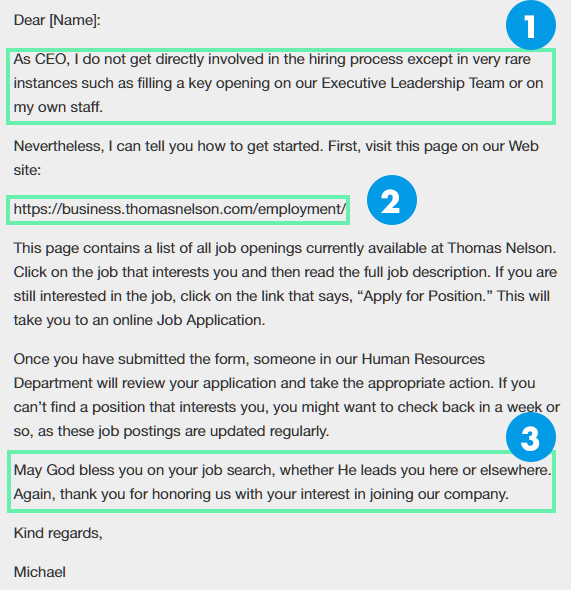
Michael’s email is extremely kind and has the same steady, generous tone of his blog. Plus, it’s easy to personalize and doesn’t look like a cookie-cutter automated email.
Here’s what I love about it:
- Explain why you can’t help. You might be tempted to say “I’m busy!” but you can do one better and tell the recipient exactly why you can’t reciprocate: you have other commitments or you just don’t handle that work.
- Tell recipients where they can get help. It’s no good telling people that you can’t help – you should also point them in the right direction. In this case, Michael directs the recipient to a resource page on his company websites and offers pointed instructions on how to submit an application. This is copy-pasted content but you wouldn’t know it at first glance.
- Thank the recipient for the email. What kind of copy you include in the “thank you” paragraph is up to you, but Michael’s idea of “honoring us with your interest” is a solid one. It’s impossible to not smile a little if you got that note in your rejection email.
Saying “no” to unsolicited questions
If you’re in any kind of visible leadership position, you’ve likely received emails from other business people asking you for advice or “just 20 minutes of your time”.
While you would love to help them out, you just don’t have the time.
Here’s how Michael deals with this (while generating leads for his services):
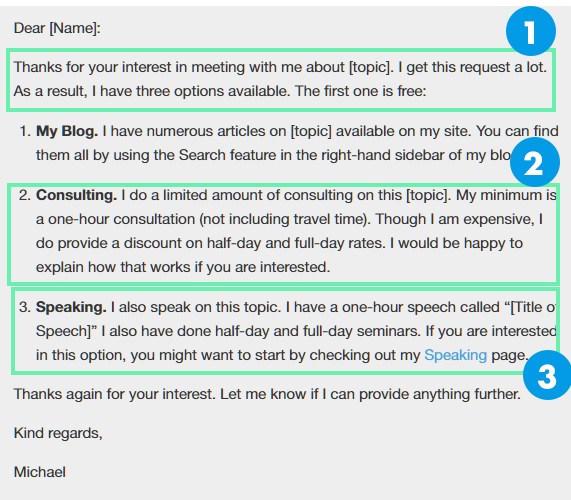
This has the same gracious tone as his job application rejection email, except it also includes a plug for his consulting and speaking services.
- Offer a “free” resource or service. Not everyone who asks you a question can afford to pay you for consulting. If you have a blog or a resource library, point recipients here – it’s the only fair thing to do.
- Offer paid alternatives. Instead of rejecting the email altogether (or not replying to it), give recipients an option to buy your time. While you don’t have to include actual rates, it is a good idea to tell people that you won’t be cheap – you don’t want to waste time dealing with tire kickers.
The inbound lead follow-up
A lead might have read dozens of blog posts and followed you across social media. But the first business email template you send the lead is the actual start of your business relationship. After all, this is the first intimate, direct conversation you’ve had with them.
For an effective inbound process, you should resist the urge to sell here. Instead, do what you’re already doing – helping the lead.
Here’s a template for following up to an inbound lead:
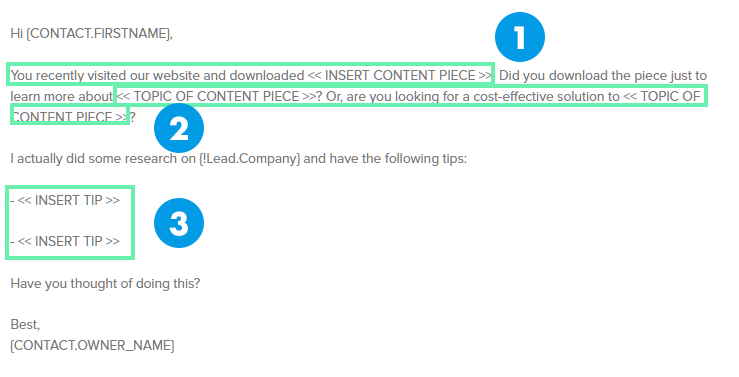
Notice these things:
- Remind the lead of the context of your email. The lead might have downloaded multiple resources that day. It’s always a good idea to remind them where you got their email information from.
- Ask if they want more information. Useful content is the foundation of inbound marketing. Ask the lead if they want more information, then direct them to the right resource.
- Share tips. This could be generic tips (for an automated email) but you’ll see much better results by sharing personalized, pointed tips. These should be relevant to the resource the lead downloaded and your business’ expertise. Say, if you sell a content marketing tool, you could mention how their blog page doesn’t have a way to capture leads. Another example might be if you’re selling marketing plans or marketing strategy strategy consulting you could mention that you can see that they might need help to <insert one weak point you see with their blog or site> and you can help with that – for example: Adjust their conversion on their blog.
The automated inbound lead follow-up email
Did you know that responding to an inbound lead within 5 minutes increases chances of conversion by 900%?
Obviously, you can’t send a highly personalized business email template in 5 minutes. The best you can do is to personalize a template and send it automatically to every incoming lead.
Here’s a template you can use for this:
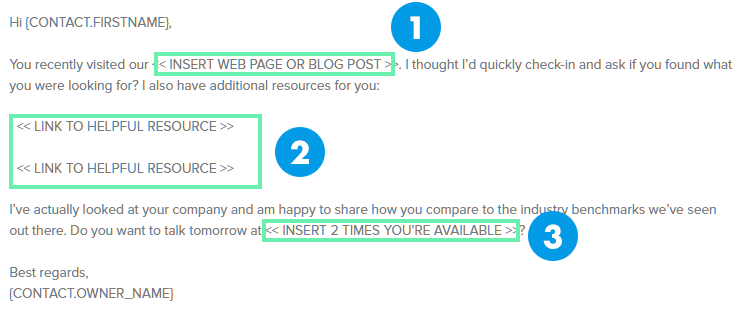
This email doesn’t require a lot of information to sound like it’s personalized. You can:
- Use the resource name. It’s better to use the actual name than add a link to the resource. This not only reminds the lead of the context of your conversation but also personalizes the email.
- Link out to additional content based on downloaded resource. You can have generic rules for linking out to different content based on the resource downloaded. For instance, you can link out to your social media blog posts for someone who downloads a “social media 101” eBook.
- Include time slots when you’re free. Say, if you are free every Thursday and Friday at 2pm, include this in all automated emails. It’s not always a great idea to try to talk in the first email, but if you feel that the lead is warm enough after asking the right sales probing questions, you can give this a try to make the sales email sequence faster.
- Subject Line: This could be a simple “Quick Question” or “Appropriate Person To Ask”
Both the above templates come from HubSpot
Introducing yourself to a contact
Let’s say you want to expand your business to a new area (say, cybersecurity). Your friend, Mike, asks you to get in touch with his friend, Matt, who is an expert in cybersecurity.
What kind of business email template should you send Matt?
Here’s a template from Danny Rubin for this situation:

As far as emails go, this is pretty straightforward – and that’s exactly the point. In an introduction email, you want to be compact and precise – tell recipients who you are and what you need from them. The fact that you’re coming from a common contact means that you already have their attention.
This email does that perfectly.
- Mention the recipient’s field. If you were an expert on VPNs, an email that mentioned your expertise would likely get your attention. This email does precisely that with its subject line.
- Keep your introduction short. You don’t need to tell the recipient anything beyond your name and critical background info. Remember: since you have a common contact, you’re already “vouched” in the recipient’s eyes.
- Give a reason for the email. In short, state why you’re emailing. The because here is critical – as I mentioned before, it gives your email a purpose and increases chances of success.
- Ask for a big favor, then a small favor. In all likelihood, the people you’re emailing would be busy. When you offer to grab a cup of coffee, they might show some resistance. In contrast to that, an offer for a phone call sounds downright easy. Stacking your requests this way means that your second offer (a phone call) sounds much more attractive when contrasted against the original request.
- Subject line: looking for advice about <insert specific area of study>
The “welcome” email
This isn’t really all of you will have to do, but if you have a product or service people can sign-up for (like JustReachOut), the “welcome” email will be one of the most important emails you send.
After all, this is the first email you send out to new users. You want this experience to be positive and informative. How the user sees you and your product/service will depend on this first interaction.
Here’s a business email template from Dan Martell of Clarity that works particularly well:

Look what Dan’s doing here:
- Email comes from a person, not a generic email address. No “noreply@yourbusinessname.com” – this one is coming straight from the company’s founder. Also notice the Clarity logo in the user avatar (from Google+).
- The reason for the email. Sure, a simple “welcome!” message works, but you can go into a bit more detail and state exactly why you’re emailing to give better clarity to your users.
- Casual tone (and useful information). Note how the email uses a very casual tone and lists exactly what it will “show” the recipients. This is a matter of branding but when you’re emailing as an individual, you really can’t go wrong with a conversational tone.
Even More Resources
Just like my last post on email templates, I want to close by giving you a list of resources you can use to learn about business email.
In fact, I’m even going to reuse the
These are resources I’ve personally used to build connections, score interviews, get guest spots, introduce new people, and of course, make sales.
Here you go:
GoodEmailCopy.com
Whenever I get stuck or can’t think of anything worthwhile to say in my emails – or how to say it – I head to GoodEmailCopy.com
This site curates emails from some of the web’s best brands. Use it to find inspiration and to see how the world’s best brands increase conversion rates.
Newsletter Template
As you know email is 40x more effective in acquiring customers vs. social media. Growing your email list is a no brainer for any business. Knowing what to send them is something I always struggle with. I usually turn to this article from Vengage which shares 67+ examples and tips to write your own newsletter template.
Definitive Guide on Email Marketing For Beginners
Email marketing is an art form and if you’ve never done it before it’s really useful to have a guide with real life templates and examples you can reference.
When I first started with email marketing I did not have something like this in front of me and as a result made similar mistakes over and over again.
I like this guide from GetResponce because it’s narrated by a real person, there is an audio component of the guide which is really nice.
This guide from GetResponse will help you get your feet wet when it comes to email marketing, if you’re new to this practice this is a great post to start with.
25 Emails that Target Each Stage of the Customer Lifecycle
Want to send emails to a top of the funnel customer? Customer service teams send these emails all the time. How about a late funnel customer who is just about to buy from you (and needs a final push)?
These 25 emails cover every stage of the customer lifecycle. Reference it when you’re stuck for ideas and need some guidance.
[Benchmark] What’s a Good Email Open and Click Rate?
How do your business emails stack up against the competition?
Use this benchmark data from HubSpot to figure it out.
How to Create an Effective “Welcome” Series
I’ve touched upon welcome emails only too briefly. This post from Emma goes much, much deeper than I could go. A MUST read if you’re writing emails to welcome your new users.
How to Generate More Sales from Your Email Marketing Campaigns
Crafting a great email is only one half of the business email equation. There are plenty of other nuts and bolts you need to tinker with to get actual sales and conversions.
This post from the always great Peep Laja throws light on some tactics you can use to turn email opens into $$$.
A/B Testing Guide for Emails
Marketing is all about testing, and that includes your business emails.
But how can you A/B test your emails?
Read this post from Zapier to find out.
Over to You
So that’s a wrap! I hope these templates and resources have been as useful to you as they have been for me.
Before you go, make sure to download the templates which I’ve personally used to get a response from some of the world’s busiest people.
- Statista’s thoughtful customer-centric email
- The benefit-focused follow-up business email template
- The lead tracking follow-up
- Following up to a warm lead
- Emailing a referred lead
- Sending warm leads more content
- Follow up after a phone call
- “Breaking up” with a prospect
- The humorous “break-up” business email template
- The congratulatory “new announcement” business email template
- The value addition business email template
- The introduction business email template
- The “get back in touch” email
- Rejecting a job application
- Saying “no” to unsolicited questions
- The inbound lead follow-up
- The automated inbound lead follow-up email
- Introducing yourself to a contact
- The “welcome” email
- GoodEmailCopy.com
- Newsletter Template
- Definitive Guide on Email Marketing For Beginners
- 25 Emails that Target Each Stage of the Customer Lifecycle
- [Benchmark] What’s a Good Email Open and Click Rate?
- How to Create an Effective “Welcome” Series
- How to Generate More Sales from Your Email Marketing Campaigns
- A/B Testing Guide for Emails
Very helpful tips Dmitry 🙂 I was wondering how many follow up emails do you send? and when is the right time to send them?
Hey Dmitry!
First off, I should commend you on a well-written post…this is definitely an helpful post!
I have tried some of these techniques with my own list and they’ve surely worked magic for me and even for some of my clients.
I have often opined that what makes a list effective is not the autoresponder you use but rather, the quality of your copy and how you relate with the guys and chicks on your list. Relationships is the highest need in the world and your emails should create and attract a good relationship with your list subscribers. Simple!
I will definitely try out some of the templates you have shared here, Dmitry. Thanks man. 🙂
Anil
Cheers! Thanks Anil.